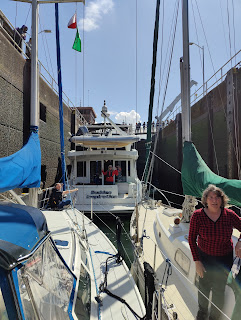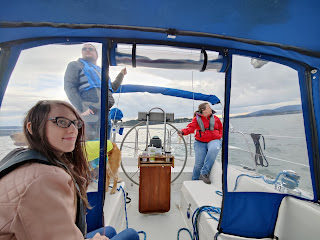We took our Catalina 320, currently named Skål, out for our first time away
from the dock since the sea trial. We will get to that in another post, but
we've been busy for the last six weeks. We have had engine maintenance, sail
maintenance, and other general work to get her ready to go. Our first issue
was getting her insured. We went back to BoatUS, who has been our insurance
company on Fantasia. They looked at the survey that had been done, picked what
seems like an arbitrary four things that had to be fixed before they would
insure the boat. Not only did we have to fix them, but we had to have our
surveyor come back out and verify they were fixed. So we did.
Out of the things on the survey, they decided that we had to replace the
exhaust hose, fix the bilge pump hose, stop a really minor deck leak of the
port mid-ship stanchion, and put some chafe guard on some engine water hoses.
Other things like a dead carbon monoxide detector didn't matter to them, which
I'll come back to in a bit. The exhaust hose was at end of life, but really
didn't need replacing before insuring the boat. But fine. We got 20 feet of
exhaust hose (we needed maybe 12) and replaced it. We rebedded the stanchion,
which was relatively easy except getting access to the nuts inside the boat
was tricky. The chafe guard on the hoses took minutes to fix. The bilge pump
hose had a minor split that needed repair, which we did. We would have got to
all of these, but probably with a different priority if the underwriters
hadn't chosen the priority for us. We could have chosen a different insurance
company, but we were going to fix them anyway.
The mainsail was missing four of the slugs that hold it to the mast. So we
took it in to Doyle Sails and had them fix that, as well as add a second
reefing point on the sail. We also had the Dutchman system on the sail
repaired as the filaments were broken. The gate that allows you to remove the
mailsail from the mast was installed with non-stainless screws, which had
rusted and caused their heads to break off. We had to drill them out and
re-tap them. Do not use hardware that isn't stainless on a sailboat!
The Perkins M30 engine the boat comes with was running rough, so we had Darrel
at Fathom Marine Services do some overdue maintenance. The M30 has a notorious
problem that the exhaust elbow part gets clogged with carbonization. Sure
enough, it was bad enough that the part had to be scrapped and a new one
ordered from England and expedited out. (If you have an M30, get the elbow
checked!) We got all the fluids changed, the timing on the engine fixed, and
the idle changed, replaced the impeller, etc.
We had Kent from North Sound Rigging come out and do a rigging inspection. He
mainly noted that our standing rigging and lifelines are at end of life. You
are supposed to replace the standing rigging every ten years, and ours are 28
years old. Still, there was nothing that looked terribly wrong, so we are
scheduling that for this fall. The lifelines, though, will get replaced
earlier. He also noted that the shroud boots needed replacing, two cam cleats
on the traveler was dead (we had already noted that and replaced them with new
Harken cleats before he gave us the report), and a few other items. Basically
we need standard rigging maintenance, but nothing that said don't sail.
We could have had the rigging inspection required before buying the boat, but
we didn't feel that anything he would have to say would change what we decided
on the boat, just what items were on the list.
We replaced a bunch of outdated or dead safety stuff on the boat. The flares
were from the 1990s. The fire extinguishers were old, too, and certainly don't
meet the new Coast Guard specs that come into play this month. We replaced
those. We replaced the dead carbon monoxide detector in the salon with a new
Kidde smoke and carbon monoxide detector. We added a second one to the aft
cabin where there had never been one. We replaced the dead GFCI AC sockets.
Why weren't these things weren't important to the underwriters?
We replaced all of the interior incandescent lights with new LED lights that
are both brighter and use less battery. We added labels to the electrical
panel. We added a wire tie to the macerator to make it so it can't be opened
in the Salish Sea. We fixed the handle on the head door. We replaced the wing
nuts on the battery terminals with regular nuts, and found one of the battery
terminals had cracked, so replaced that. We topped off the water in the
batteries. We added Froli bed springs to the bed in the aft cabin. We replaced
the cover to where the emergency tiller attaches because the handle was
broken.
As noted on the survey, the drain on the propane locker was clogged. This is
important because it is the exit point from the boat if the propane tank
leaks. You don't want propane on a boat because it tends to go boom! Except
you need propane on a boat to run the stove. So you isolate it and make sure
that any leaks go overboard rather than sinking into the bilge where a spark
causes bad things to happen. A clogged hose leaves propane on the boat. We
replaced that hose (43" of 1" hose), also finding that there was a screen
placed at the end of the hose to keep bugs out that had been completely
clogged with debris. We removed that screen.
We have an Ardic diesel heater on the boat. The unit is in the starboard aft
lazerette. This pumps out a ton of heat. Unfortunately, there seems to be a
leak in the exhaust, because it caused the brand new carbon monoxide detector
to go off at 1 a.m. If we hadn't installed that in the aft cabin, it literally
could have killed Sandi. We have since added a third carbon monoxide detector
in the lazerette next to the heater. If there is one thing the underwriters
should have insisted on was new detectors. We haven't fixed the heater yet,
but we aren't running it until we do. Since we are at the marina, we are using
an electric heater for now.
None of these things are surprising on a boat. Every boat has a list like
this, even brand new boats. (We use Microsoft To Do to maintain our lists,
which allows modifying them from any device.) We just are doing all of this
stuff at once rather than stretching it out. We learned so much doing work on
Fantasia, our Catalina 22, that prepared us for taking on this boat.







